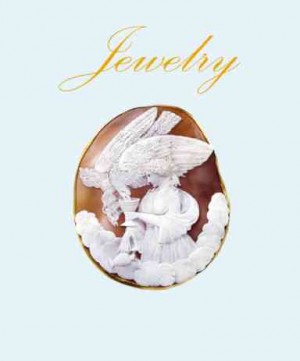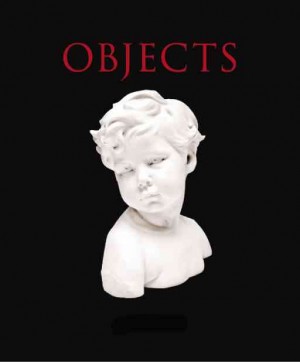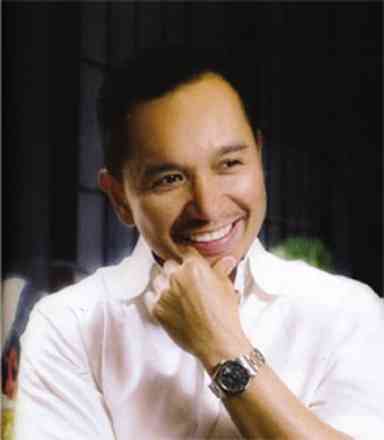
The interview begins with our subject’s reference to a cartoon about generations from a San Francisco publication: “When are you going to be relevant?” asks the baby boomer of the millennial.
To which the millennial shoots back: “When are you going to be hip?”
Federico de Vera, the 52-year-old New York-based jewelry designer, connoisseur, entrepreneur and author, is neither of the two. He expresses a viewpoint that is beyond time, culture and trend. His two self-published books, “De Vera Jewelry” and “De Vera Objects,” recreate the ambience of his two stores. They depict a rarified world of objets d’art where the old, the new, the beautiful and the surreal meet.
De Vera was in Manila to promote his books last Friday at the Celestina boutique in Greenbelt 5.
Although De Vera established his venture from collections of rare finds, half of his business comes from jewelry—his and those of other featured designers. De Vera’s jewelry is crafted from antique treasures, spontaneously combined with nature forms and unusual details. Likewise, the other collection is a motley of antique silver and modern bronze sculptures and religious icons; excavated vessels coexist with corals and shells.
In all, he built his reputation on his unerring taste and penchant for the unexpected. The New York Times describes him as an “aesthetic savant.”
The De Vera stores in New York are described as “The Ultimate,” a must-go destination in the top guidebooks, including the Louis Vuitton City Guides.
Unexpected details
Asked why he produced the book, De Vera candidly replies with a chuckle: “Everybody makes one.”
He goes on to explain his perspective. “Some people claim to have a viewpoint, but do they really have one? I have a singular point of view. It’s like being a Filipino who is acculturated with various influences and more. Hence, the book.”
“De Vera Objects” features Don Freeman’s images of the author’s stores and homes and reflections of his client-friends, such as cosmetics heir Ronald S. Lauder, design expert Diane Dorrans Saeks and Michael Maharam, head honcho of a prominent supplier of textiles for the design industry.
“De Vera Jewelry” showcases his works, which are immortalized by Colombian photographer Anita Calero. He invited clients from the fashion world such as designer Paul Smith, photographer Bruce Weber and celebrity stylist Lori Goldstein to write.
“De Vera Jewelry” says more about the author and his penchant for the unexpected.
Like a halo, a necklace of delicately carved lava pebbles from Italy frames a saint in an antique print.
With a fetish for architectural salvaged body parts, he artfully composes a layout of an antique carved wooden hand from Colombia holding an onyx necklace with a pendant made of coral, diamond and citrine. He matches it with miniature ivory hands attached to delicate branches of black and red coral.
An architectural fragment of a gilded baroque leaf is arranged with an ancient Roman earring and De Vera’s teardrop pearl danglers. Atop another antique print, an exaggerated Victorian cameo brooch of a woman feeding a bird modestly covers the drawing of naked figure, while a winged male playfully holds up a diamond-encrusted abalone brooch.
 An 18th-century porcelain salt container is reimagined into a pendant of a masked lady with a bouffant powdered wig.
An 18th-century porcelain salt container is reimagined into a pendant of a masked lady with a bouffant powdered wig.
It takes a fine eye to appreciate history, especially in today’s world, which is exposed to fine jewelry, thanks to red-carpet glamour. De Vera reverts to estate jewelry from the late 18th to the early 19th centuries, during the era of King George.
Called Georgian jewelry, they were fashioned from hand-cut glass in an intricate setting. This art is shown in a series of seed pearl brooches executed with painstaking workmanship.
Then there’s the playful irony. An old print depicts a cherub sleeping peacefully aloft a cross as it is surrounded by black mourning jewelry, mostly antiquated brooches, popularized by Queen Victoria.
In late 19th-century England, the lock of hair of the deceased was woven and preserved in a locket. De Vera discovered an artisan who knew the craft and helped him create a necklace of locks of hair in various colors.
Developing aesthetics
De Vera’s journey began in Dagupan, Pangasinan, where he was born to a well-to-do and landed family. The parents set up a cottage industry, Romana’s peanut brittle, which has become an institution.
 Since childhood, De Vera would gather shells, driftwood and rocks on the family’s 25-hectare property along the beachfront in San Fabian, Pangasinan. The hours spent in immersing himself, studying their forms and textures, must have rubbed off on his aesthetics.
Since childhood, De Vera would gather shells, driftwood and rocks on the family’s 25-hectare property along the beachfront in San Fabian, Pangasinan. The hours spent in immersing himself, studying their forms and textures, must have rubbed off on his aesthetics.
He also acquired his mother’s taste in jewelry. In his youth, he would help her choose the jewelry by examining their attributes, and recommend the piece best suited to complement her wardrobe.
As an architecture student at the University of Sto. Tomas, he spent more time studying design and decorative arts rather than structures. He questioned the way professors imposed their viewpoints on students. In a design class, his teacher disapproved of De Vera’s rendering of a contemporary building, the idea of which seemed very forward then.
As a compromise, De Vera submitted a design with ornate Spanish colonial influences just to get a passing mark. Dissatisfied, he then realized that he would never concede to convention.
During his free time, he would scour the flea markets in Quezon City and Makati, and antique shops such as Jo-Liza.
“I started refining my taste. Little did I know that I was scratching the surface. If you want knowledge, you don’t need to go to school. As I got older, I just read about objects and handled the pieces and traveled more often,” De Vera says. “When you see the Gothic Revival in the San Sebastian Church, at first, you’d think it’s, wow! In Paris, you see genuine Gothic.”
In 1984, he moved to San Francisco to study business. He took a job at a gallery shop in Fisherman’s Wharf, convincing customers of the merits of tasteless artwork. Again, feeling he was compromising on his aesthetics, De Vera sought other jobs.
Working at Japonesque Gallery, a style arbiter for Asian design, De Vera cultivated a taste for purity of form and line. But after several years, the clean aesthetic began to bore him. He missed the splendor of Old World design and also hankered for innovation.
Crème de la crème
In 1991, he opened a store in Hayes Valley and named it after his surname. The De Vera store displayed rare European and Asian objets d’art against a white background like artworks in a gallery.
“When you visit the museum, there’s the impulse to buy something so badly. You want to be a part of that experience. That’s how I want my shops to be,” he says. De Vera expanded to another store dedicated to European glass.
De Vera’s foray into jewelry was a stroke of luck. He strung seeds on a leather cord, and sold it for $18 to pay for lunch money for the staff. There is the oft-repeated story of De Vera having a light-bulb moment on seeing the drawing of a third-century Greek gold necklace from a book. He fashioned his version using mother-of-pearl, seed pearls and wire.
As the business flourished, the two De Vera stores moved to Union Square, with one of them focused on jewelry.
Since many of De Vera’s clients came from New York, he decided to open two stores in the Big Apple in 2002. For nearly a decade, he would shuttle between the east and west coasts. Last 2010, he folded up the San Francisco business, weary of the laid-back lifestyle.
“If I stayed in San Francisco, I’d get old,” he says.
The transfer was also tactical. “People spend more money in travels. The rich people go to New York to buy. We even had clients from San Francisco who didn’t know I had stores there. They’d shop in New York instead.”
The press—New York Times, New York Magazine, Elle Décor, Vogue—has gushed over his stores. It is patronized by the crème dela crème. Designers Karl Lagerfeld, Giorgio Armani, Valentino, Marc Jacobs, Thom Brown and Nicholas Ghesquiere, Vogue creative director Grace Coddington, author Daniele Steele, the late visionary Steve Jobs, actor Daniel Day-Lewis, singer Usher and TV anchor Matt Lauer are just some of the name-droppable clients.
His jewelry is worn by powerful women such as former first lady Hillary Clinton. In one of her many appearances on Barbara Walters’ show, Clinton wore De Vera’s South Sea pearl necklace. One of the ladies from the Haas family, owners of Levi’s, owns De Vera’s bib necklace, made of 22-karat gold and opals, inspired by a Florentine design. Friends of Vogue editor in chief Anna Wintour shop at the De Vera store in New York to buy her presents.
Car accident
However glamorous and rarified the De Vera world seems to be, he has his human side. For one, he freely shares his talent to help people.
During the term of the late executive director Araceli Pinto-Mansor of the Center for International Trade Expositions and Missions (Citem), De Vera would fly to the Philippines to conduct seminars and develop products for manufacturers on a voluntary basis.
Upon the invitation of Colombian-born social entrepreneur Lizzie Eder Zobel’s family, he spent a month in the capital, Bogota, at his own expense, to teach in a vocational school for leather, woodworking metal and embroidery.
“Their work was similar to that of the Philippines—too traditional and tacky. I taught the teachers how to design and to see things from a different viewpoint,” says de Vera. He imparted that the artisans could apply the same techniques in more tasteful designs.
Consequently, the artisans produced objects for the De Vera stores, some of which were photographed in his books, such as a carved leaf and hand-embroidered bag.
All the sales from last Fridays book signing event will go to Zobel and Margarita Delgado’s advocacy, Teach Philippines.
In the course of the interview, De Vera reveals his closeness to the family. One of his most prized possessions is his mother’s engagement ring, a yellow diamond set on electron, which is half gold and half silver.
He once gave his mother an eight-karat diamond, which she would wear whenever they met. One day, de Vera noticed that the ring was missing. She admitted that it had been lost, more like stolen. Nonchalantly, he shrugged off the loss and told her, “It’s just a ring.”
There were greater losses, such as the deaths in the family. Last year, De Vera came home to attend the funeral of his 16-year-old nephew who died in a car accident. The nephew was a month old when his parents and sibling also perished in a car accident.
De Vera also had his brush with fate. Two winters ago, he was driving a Porsche with a companion in upstate New York. The snow made the road slippery and the car lost its breaks. The car hit a rail and slid down the slopes toward a farm. De Vera and his companion thought it was the end until the car came to a halt. Since the 911 line was not answering, it took them hours to find their way back to the main road.
These experiences made De Vera realize the transient nature of life. “The things that we own are not permanent. They may make you happy now. But if you lose something, it’s not the end of the world.”














































